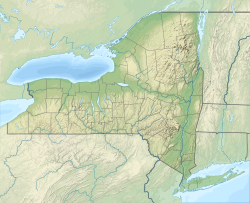| Cayuga Creek | |
|---|---|
 Cayuga Creek in Lancaster | |
| Location | |
| Country | United States |
| State | New York |
| Region | Western New York |
| Physical characteristics | |
| Source | |
| • location | Wyoming County |
| • coordinates | 42°42′48″N78°21′53″W / 42.71333°N 78.36472°W [1] |
| Mouth | Buffalo River |
• location | Erie County |
• coordinates | 42°52′12″N78°47′10″W / 42.87000°N 78.78611°W [1] |
| Discharge | |
| • location | Lancaster, New York [2] |
Cayuga Creek is a small stream in western New York, United States, with stretches in both Erie County and Wyoming County. [1] The creek enters Buffalo Creek in the northwest corner of the Town of West Seneca in Erie County, just upstream from the New York State Thruway crossing. At that point, Buffalo Creek becomes the Buffalo River and flows into Lake Erie near Buffalo, New York.
Contents
The creek is named after the Cayuga nation, one of the constituent members of the Iroquois Confederacy.

